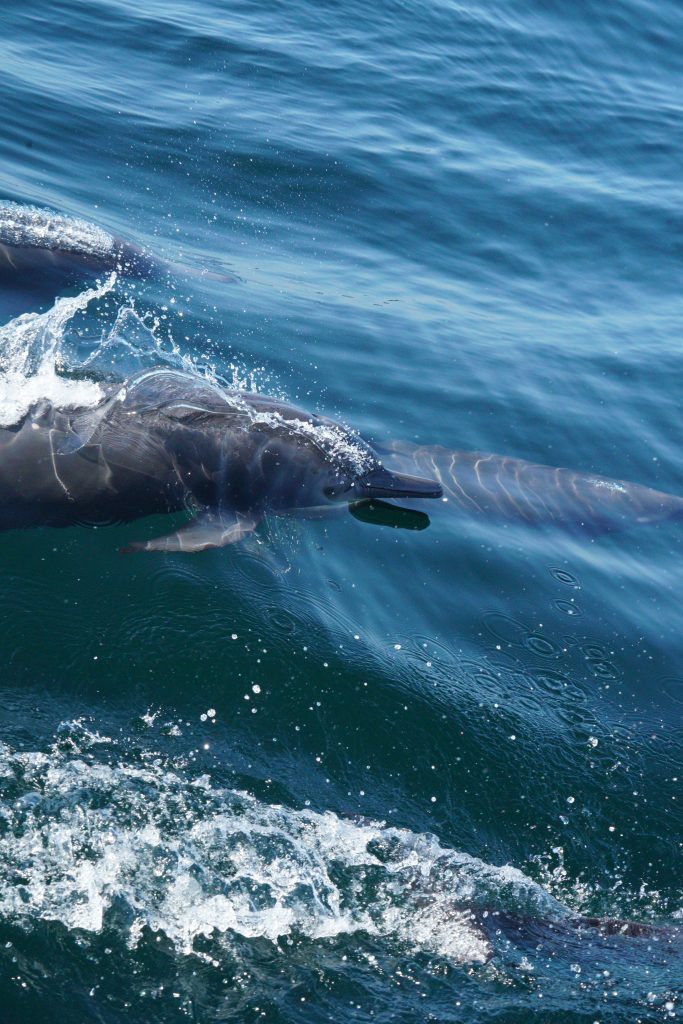
Strait of Gibraltar
Located at the fissure between the Eurasian plate and the African plate, the Strat has a longitudinal extension of 60 km and a maximum depth of almost 1000 meters. The predominant winds are from the west (Poniente) and east (Levante) of strong intensity. In this area there is a mixture of marine currents from both the mediterranean sea and the Atlantic ocean, which results in vertical upwelling and phytoplankton blooms on the surface, translating into a large primary production.
A total of nine species are commonly found in the area. Four of these species live in these waters all year round: common dolphins (Delphinus delphis Linnaeus, 1758), striped dolphins (Stenella coeruleoalba (Meyen, 1833)), bottlenose dolphins (Tursiops truncatus (Montagu, 1821)), and long-finned pilot whales (Globicephala melas (Traill, 1809)). It is quite easy to observe bottlenose dolphins jumping on the bow of the boats, hundreds of striped dolphins sailing, or pods of pilot whales curiously approaching vessels.
However, the high peak starts from spring to autumn, when Strait becomes a highway for various cetacean species, such as sperm whales (Physeter macrocephalus Linnaeus, 1758), orcas (Orcinus orca (Linnaeus, 1758)), and even fin whales (Balaenoptera physalus (Linnaeus, 1758)). Sperm whales, once hunted by the whaling industry in the area, are present in the area mainly during spring and autumn. They are individuals from the Mediterranean subpopulation, genetically distinct from adjacent Atlantic populations and with no apparent flux with them. We rarely encounter groups of Sperm Whales in the Strait, they usually seem to be males feeding alone, the so-called ‘bachelor groups’. Another seasonal species is the Orca. In the Strait of Gibraltar, there is a subpopulation called the Iberian Orca. They are considered distinct from other Northeast Atlantic subpopulations, according to studies of photoidentification, mitochondrial DNA, microsatellite genetic markers, stable isotope ratios and contaminant loads. This subpopulation rely heavily on an endangered prey species, Atlantic bluefin tuna, for which they come in small groups during the summer to feed on, because tuna is migrating at this time to spawn in Mediterranean waters. Orcas are very resourceful in developing hunting techniques, and here, they learned to steal tuna from the hooks of Moroccan and Spanish fishermen. It is certainly a show to witness!
Finally, the largest cetacean in the Strait is the fin whale, second largest animal on earth, which can reach 22 meters. In early summer, they start their journey from the Mediterranean Sea to the Atlantic Ocean in search of cooler waters. And in autumn-winter, they do the reverse journey. Since it is a migratory species, they are the most difficult ones to watch. Also called the greyhounds of the sea, fin whales are capable of crossing the Strait in one hour.
Concerning whale-watching, most boats operate only during the warmer months, while in winter, these sailors return to their fishing profession. This dual identity is both a strength and a challenge. On one hand, conservation initiatives have the potential for multiplied impact: one sailor might influence not just tour practices, but also fishing habits. On the other hand, it becomes challenging to point out unsustainable practices when they have been part of a person’s lifelong work, making it sometimes hard to implement more science-informed approaches.
During the excursions, the navigation around the cetaceans needs to follow the regulations of Royal Decree 1727/2007, which limits the area of approach to a radius of 60 meters from the animal, a restricted area of permanence between 60 and 300 meters, and an area of approaching between the 300-500m. If cetaceans approach within 60 meters (200 ft) of the boat, the crew must put in neutral, disengage or stop the engine if necessary.
So, which companies should you go for? Depends on what you prefer. There are no whites and blacks in this business, and it largely depends on the person driving the boat, rather than the company itself. If you are keen on having fewer people on board, two great options are Ecolocaliza and Estrecho Natura. They are both located in Algeciras Bay, perform scientific work on the side and are especially concerned about performing respectful, non-invasive whale watching.
Another important factor is the location of the strait, at the crossroads of two continents and two waters. It makes it one of the most biologically diverse and rich marine zones in Europe, but also means that cetacean conservation here is an international puzzle. With approximately 300 ships passing through daily, the Strait of Gibraltar is one of the busiest maritime waterways in the world. Coordinated management between the maritime authorities from Spain (and European Union), Morocco, and UK, is critical for an effective regulation of local threats, such as marine shipping, ferry routes, illegal fishing, and both acoustic and chemical pollution. Without that, even the most well-intentioned whale-watching efforts seem futile. In conclusion whale watching in the Strait offers one of nature’s spectacular shows, and to ensure this spectacle endures, a cohesive efforts are needed at both local and internation scales.
